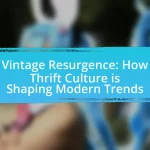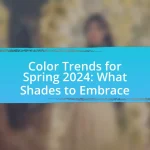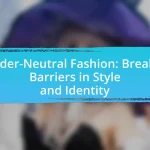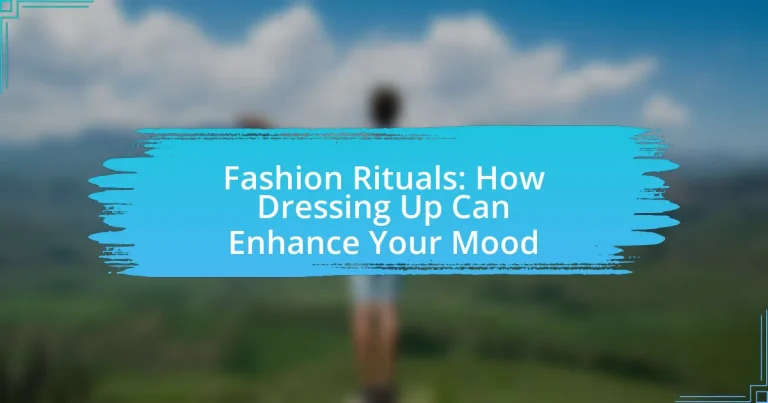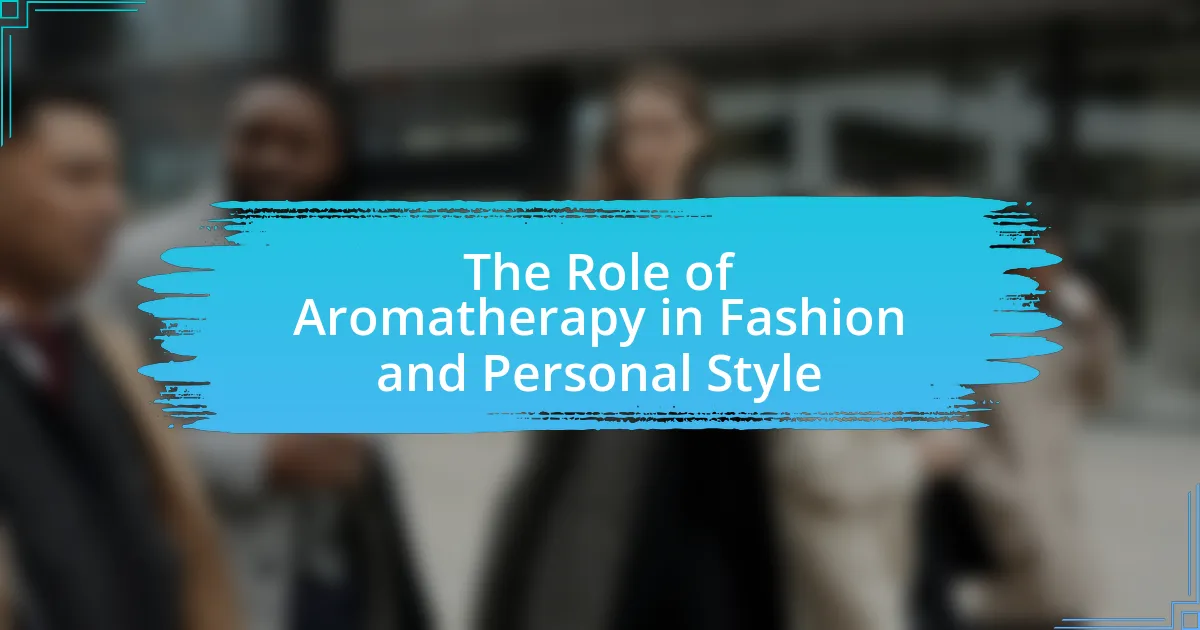Fashion rituals are intentional practices related to dressing and personal style that enhance mood and self-expression. These rituals, which include selecting outfits, accessorizing, and grooming, significantly influence self-perception and social interactions, contributing to emotional well-being and self-esteem. Research indicates that dressing well can positively affect cognitive processing and mood, highlighting the psychological benefits of fashion. The article explores various aspects of fashion rituals, including their impact on daily life, cultural differences, and the psychological effects of dressing up, while also providing practical tips for creating personal fashion rituals that align with individual moods and preferences.
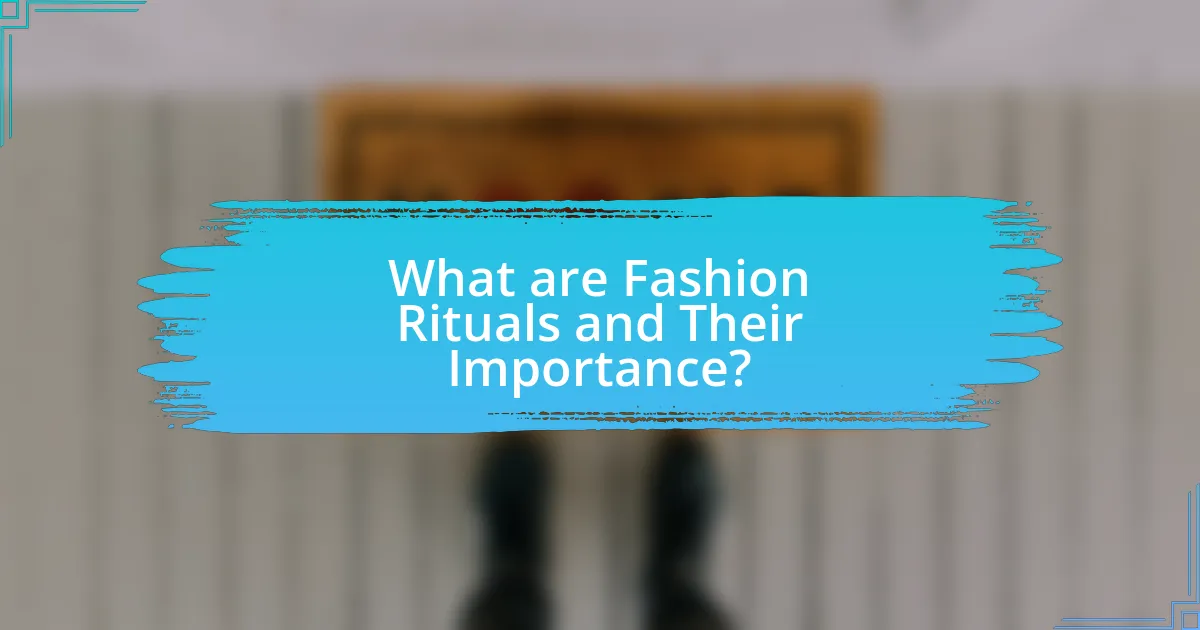
What are Fashion Rituals and Their Importance?
Fashion rituals are intentional practices related to dressing and personal style that individuals engage in to enhance their mood and self-expression. These rituals can include activities such as selecting outfits, accessorizing, and grooming, which contribute to a sense of identity and confidence. Research indicates that dressing well can positively influence psychological states, as evidenced by a study published in the Journal of Experimental Social Psychology, which found that participants who wore formal clothing performed better on cognitive tasks, suggesting that attire can affect cognitive processing and mood. Thus, fashion rituals play a significant role in promoting emotional well-being and self-esteem through the act of dressing.
How do fashion rituals influence our daily lives?
Fashion rituals significantly influence our daily lives by shaping our self-perception and social interactions. Engaging in these rituals, such as choosing outfits or accessorizing, can enhance mood and boost confidence, as evidenced by studies showing that individuals who dress well report higher self-esteem and improved emotional well-being. For instance, research published in the Journal of Experimental Social Psychology found that participants who wore formal clothing performed better on cognitive tasks, indicating that attire can affect psychological states and cognitive functions. Thus, fashion rituals play a crucial role in how we present ourselves and interact with the world, ultimately impacting our daily experiences and emotional health.
What psychological effects do fashion rituals have on individuals?
Fashion rituals significantly enhance individuals’ psychological well-being by boosting self-esteem and promoting positive mood states. Engaging in these rituals, such as dressing up for an occasion, can lead to increased feelings of confidence and self-worth, as evidenced by a study published in the Journal of Experimental Social Psychology, which found that participants who dressed in formal attire reported higher levels of abstract thinking and confidence. Additionally, the act of selecting and wearing specific outfits can serve as a form of self-expression, allowing individuals to convey their identity and emotions, further contributing to their overall mental health.
How do cultural differences shape fashion rituals?
Cultural differences significantly shape fashion rituals by influencing the meanings, practices, and values associated with clothing in various societies. For instance, in many Western cultures, fashion often emphasizes individualism and personal expression, leading to diverse styles that reflect personal identity. In contrast, cultures such as Japan prioritize harmony and group identity, which is evident in traditional garments like kimonos that convey cultural heritage and social status. Furthermore, specific rituals, such as the wearing of white in Western weddings versus red in many Asian weddings, illustrate how cultural contexts dictate fashion choices and their significance. These differences highlight the role of cultural norms and values in shaping not only what people wear but also how they perceive and engage with fashion as a ritualistic practice.
Why is dressing up considered a mood enhancer?
Dressing up is considered a mood enhancer because it can significantly boost self-esteem and confidence. When individuals wear clothing that they perceive as attractive or appropriate, they often experience a positive shift in their self-image, which can lead to improved emotional well-being. Research published in the Journal of Experimental Social Psychology indicates that clothing can influence cognitive processes and emotional states, demonstrating that people who dress well report higher levels of happiness and satisfaction. This phenomenon, known as “enclothed cognition,” shows that the act of dressing up can create a psychological impact, reinforcing the connection between appearance and mood.
What scientific studies support the link between clothing and mood?
Scientific studies indicate a strong link between clothing and mood. One notable study by Adam and Galinsky (2012) published in the Journal of Experimental Social Psychology found that wearing formal clothing enhances abstract thinking and increases feelings of power, which can positively influence mood. Another research conducted by Kwon and Trail (2016) in the Journal of Fashion Marketing and Management demonstrated that individuals who dressed in a way that aligned with their self-image reported higher levels of self-esteem and overall mood improvement. These studies collectively support the assertion that clothing choices significantly impact emotional states and psychological well-being.
How does the act of dressing up affect self-perception?
The act of dressing up positively affects self-perception by enhancing confidence and self-esteem. Research indicates that individuals who dress well often report feeling more competent and capable, which can lead to improved performance in various tasks. A study published in the Journal of Experimental Social Psychology found that participants who wore formal clothing performed better on cognitive tasks compared to those in casual attire, suggesting that clothing can influence psychological states. This phenomenon, known as “enclothed cognition,” demonstrates that the way individuals dress can significantly shape their self-image and how they perceive their abilities.
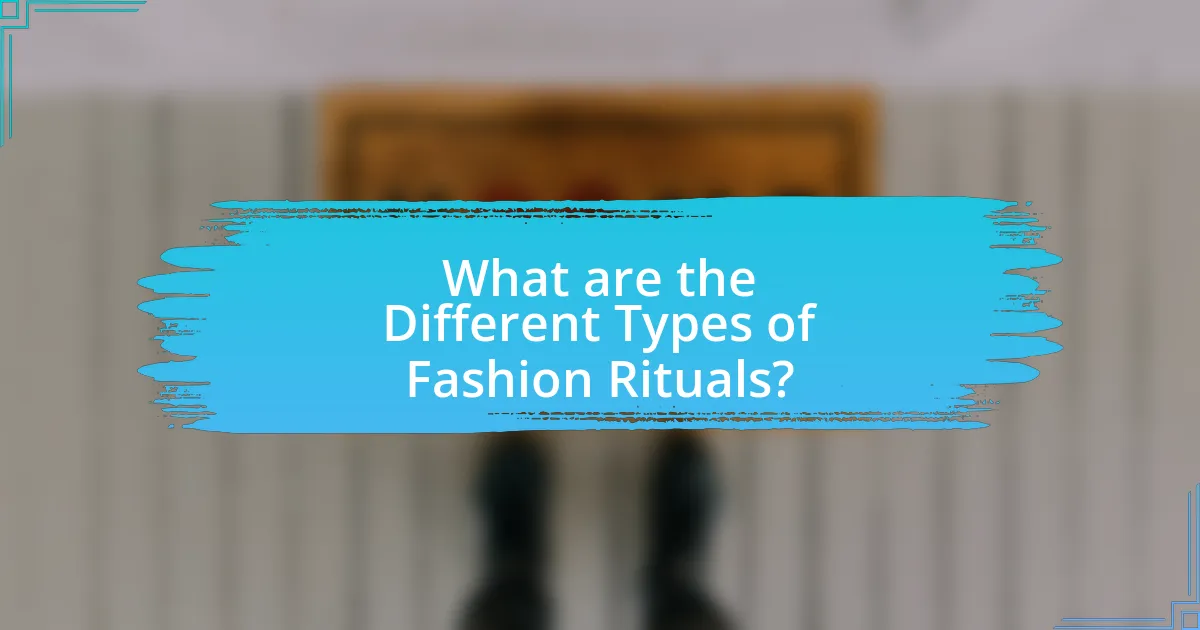
What are the Different Types of Fashion Rituals?
Fashion rituals can be categorized into several types, including daily dressing routines, special occasion attire, and seasonal wardrobe changes. Daily dressing routines involve selecting outfits based on personal style, comfort, and occasion, which can enhance mood and self-esteem. Special occasion attire, such as outfits for weddings or parties, often involves more elaborate choices that reflect cultural significance and personal expression. Seasonal wardrobe changes, influenced by trends and climate, allow individuals to refresh their style and adapt to new environments, further impacting their emotional well-being. These rituals are supported by psychological studies indicating that clothing choices can significantly affect mood and self-perception.
How do personal fashion rituals vary among individuals?
Personal fashion rituals vary significantly among individuals based on personal preferences, cultural backgrounds, and psychological factors. For instance, some individuals may prioritize comfort and practicality in their daily attire, while others may focus on expressing their identity through bold fashion choices. Research indicates that these rituals can be influenced by social contexts, such as professional environments requiring formal attire versus casual settings that allow for more relaxed clothing. Additionally, psychological studies show that individuals often engage in specific routines, such as selecting outfits that align with their mood or desired self-image, which can enhance their overall well-being and confidence.
What are common elements found in personal fashion rituals?
Common elements found in personal fashion rituals include intentional outfit selection, grooming practices, and accessorizing. Intentional outfit selection involves choosing clothing that reflects personal style and mood, which can enhance self-esteem and confidence. Grooming practices, such as hairstyling and skincare, contribute to an overall polished appearance, reinforcing a positive self-image. Accessorizing with items like jewelry or bags adds personal flair and can elevate an outfit, further impacting mood. These elements collectively create a routine that not only prepares individuals for the day but also influences their emotional state, as supported by studies indicating that dressing well can lead to improved mood and productivity.
How do seasonal changes influence fashion rituals?
Seasonal changes significantly influence fashion rituals by dictating the types of clothing and accessories individuals choose to wear. For instance, during spring and summer, lighter fabrics and vibrant colors become prevalent, reflecting the warmer weather and longer days, while fall and winter prompt the use of heavier materials and darker hues to provide warmth and comfort. This shift in clothing choices is not merely practical; it also affects mood and self-expression, as studies show that wearing seasonally appropriate attire can enhance feelings of well-being and confidence. Research published in the Journal of Experimental Social Psychology indicates that clothing can influence psychological states, suggesting that adapting fashion to seasonal changes can positively impact mood and social interactions.
What role do social occasions play in fashion rituals?
Social occasions serve as significant catalysts for fashion rituals by providing contexts in which individuals express their identity and social status through clothing choices. These events, such as weddings, parties, or formal gatherings, often dictate specific dress codes that encourage participants to curate their outfits accordingly. Research indicates that dressing up for social occasions can enhance mood and self-esteem, as individuals often feel more confident and socially accepted when adhering to the expected fashion norms of the event. For instance, a study published in the Journal of Experimental Social Psychology found that participants who dressed in formal attire reported higher levels of confidence and engagement in social interactions compared to those in casual clothing. Thus, social occasions not only influence fashion choices but also play a crucial role in shaping emotional experiences related to self-presentation and social belonging.
How do events like weddings or parties shape our dressing choices?
Events like weddings or parties significantly influence our dressing choices by establishing social norms and expectations regarding attire. These occasions often dictate specific dress codes, such as formal, semi-formal, or casual, which guide individuals in selecting appropriate outfits. For instance, a wedding typically requires guests to wear formal attire, which can include suits or elegant dresses, thereby shaping the overall fashion landscape for that event. Additionally, cultural traditions associated with weddings and parties can further dictate specific styles, colors, or accessories, reinforcing the importance of dressing in accordance with the event’s theme. This adherence to social expectations not only reflects respect for the occasion but also enhances personal confidence and mood, as individuals often feel more empowered when dressed appropriately for significant social gatherings.
What are the implications of dressing for success in professional settings?
Dressing for success in professional settings significantly impacts perceptions of competence and authority. Research indicates that individuals who dress in formal attire are often perceived as more capable and confident, which can lead to increased opportunities for career advancement. A study published in the Journal of Experimental Social Psychology found that participants who wore formal clothing performed better in abstract thinking tasks, suggesting that dressing well can enhance cognitive function and self-perception. Furthermore, dressing appropriately can foster a positive workplace culture, as it sets a standard for professionalism and respect among colleagues.
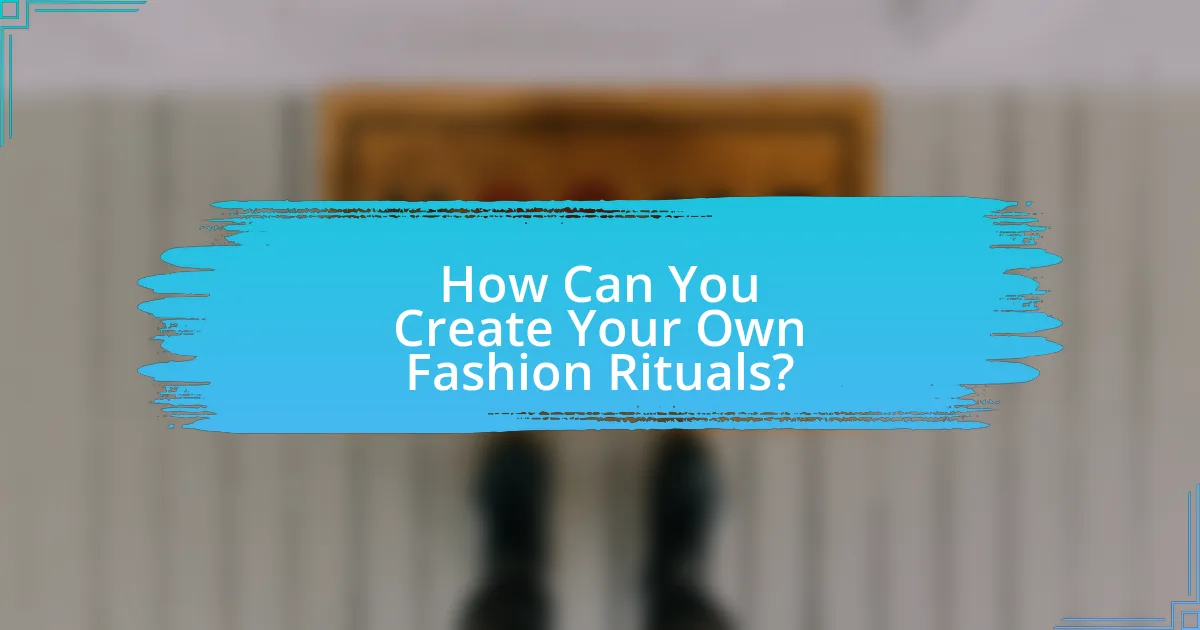
How Can You Create Your Own Fashion Rituals?
To create your own fashion rituals, start by identifying specific activities that make you feel confident and express your personal style. For example, you can establish a routine of selecting outfits based on your mood or the occasion, which can enhance your emotional well-being. Research indicates that dressing well can positively impact self-esteem and mood, as noted in a study published in the Journal of Experimental Social Psychology, where participants reported feeling more powerful and confident when wearing formal attire. By consistently engaging in these rituals, such as setting aside time each week to curate your wardrobe or experimenting with new styles, you reinforce a positive relationship with fashion that can uplift your spirits.
What steps can you take to develop a personal fashion ritual?
To develop a personal fashion ritual, start by identifying your style preferences and the emotions you want to evoke through your clothing. This involves assessing your wardrobe, selecting key pieces that resonate with your identity, and organizing them for easy access. Next, establish a routine for dressing, such as setting aside time each morning to thoughtfully choose your outfit, which can enhance your mood and self-confidence. Incorporating accessories and personal touches can further personalize your look. Research indicates that dressing well can positively impact mood and productivity, as noted in a study published in the Journal of Experimental Social Psychology, which found that clothing can influence cognitive processes and emotional states.
How can you incorporate mindfulness into your dressing routine?
Incorporating mindfulness into your dressing routine involves being fully present and intentional during the process of selecting and wearing clothing. This can be achieved by taking a moment to breathe deeply and reflect on how each piece of clothing makes you feel, allowing you to connect emotionally with your attire. Research indicates that engaging in mindful practices can enhance overall well-being, as shown in a study published in the Journal of Happiness Studies, which found that mindfulness can significantly improve mood and reduce stress. By focusing on the textures, colors, and fit of your clothing, you create a more meaningful dressing experience that can positively influence your mood throughout the day.
What are some tips for experimenting with new styles?
To experiment with new styles, start by identifying elements that resonate with your personal aesthetic, such as colors, patterns, or silhouettes. Gradually incorporate these elements into your wardrobe by mixing and matching with existing pieces, which allows for a low-risk exploration of new looks. Research shows that trying new styles can enhance self-expression and boost confidence, as noted in a study published in the Journal of Fashion Marketing and Management, where participants reported increased mood and self-esteem after adopting new fashion choices. Additionally, consider seeking inspiration from fashion influencers or social media platforms to discover fresh ideas that align with your preferences.
How can fashion rituals be adapted for different moods?
Fashion rituals can be adapted for different moods by selecting clothing and accessories that align with emotional states. For instance, wearing bright colors and playful patterns can enhance feelings of happiness and energy, while opting for soft fabrics and neutral tones can promote calmness and relaxation. Research indicates that color psychology plays a significant role in mood enhancement; for example, studies show that warm colors like red and yellow can evoke feelings of excitement, while cool colors like blue and green are associated with tranquility. Additionally, incorporating personal style elements, such as favorite accessories or signature pieces, can provide a sense of comfort and confidence, further tailoring the fashion ritual to the individual’s emotional needs.
What types of outfits are best for boosting confidence?
Outfits that boost confidence typically include well-fitted clothing, bold colors, and styles that reflect personal identity. Research indicates that wearing clothes that fit well can enhance self-perception and body image, leading to increased confidence levels. A study published in the Journal of Experimental Social Psychology found that individuals who wore formal attire reported feeling more powerful and confident compared to those in casual clothing. Additionally, colors like red and blue are often associated with feelings of empowerment and assertiveness, further contributing to a confident demeanor.
How can you use color psychology in your fashion choices?
You can use color psychology in your fashion choices by selecting colors that evoke specific emotions and influence your mood. For instance, wearing blue can promote calmness and stability, while red can increase energy and confidence. Research indicates that colors can affect psychological responses; for example, a study published in the journal “Color Research and Application” found that colors like yellow can enhance feelings of happiness and optimism. By consciously choosing colors that align with your desired emotional state, you can enhance your overall mood and presence throughout the day.
What are practical tips for enhancing your mood through fashion?
Wearing bright colors can significantly enhance your mood, as studies show that colors like yellow and orange are associated with happiness and positivity. Choosing outfits that fit well and make you feel confident can also boost self-esteem, leading to a better mood. Additionally, accessorizing with items that have personal significance or evoke positive memories can create a sense of joy and comfort. Engaging in fashion rituals, such as taking time to curate your outfit or dressing up for everyday activities, can foster a sense of purpose and elevate your emotional state.
